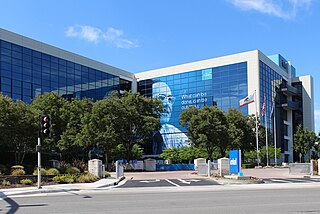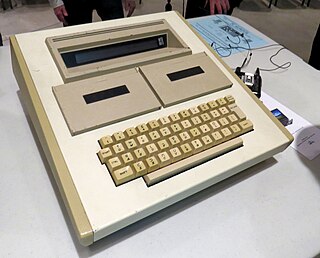Related Research Articles

Advanced Micro Devices, Inc. (AMD) is an American multinational corporation and fabless semiconductor company based in Santa Clara, California, that designs, develops and sells computer processors and related technologies for business and consumer markets.

Intel Corporation is an American multinational corporation and technology company headquartered in Santa Clara, California, and incorporated in Delaware. Intel designs, manufactures and sells computer components and related products for business and consumer markets. It is considered one of the world's largest semiconductor chip manufacturers by revenue and ranked in the Fortune 500 list of the largest United States corporations by revenue for nearly a decade, from 2007 to 2016 fiscal years, until it was removed from the ranking in 2018. In 2020, it was reinstated and ranked 45th, being the 7th-largest technology company in the ranking.

IBM PC–compatible computers are technically similar to the original IBM PC, XT, and AT, all from computer giant IBM, that are able to use the same software and expansion cards. Such computers were referred to as PC clones, IBM clones or IBM PC clones. The term "IBM PC compatible" is now a historical description only, since IBM no longer sells personal computers after it sold its personal computer division in 2005 to Chinese technology company Lenovo. The designation "PC", as used in much of personal computer history, has not meant "personal computer" generally, but rather an x86 computer capable of running the same software that a contemporary IBM or Lenovo PC could. The term was initially in contrast to the variety of home computer systems available in the early 1980s, such as the Apple II, TRS-80, and Commodore 64. Later, the term was primarily used in contrast to Apple's Macintosh computers.
Clean-room design is the method of copying a design by reverse engineering and then recreating it without infringing any of the copyrights associated with the original design. Clean-room design is useful as a defense against copyright infringement because it relies on independent creation. However, because independent invention is not a defense against patents, clean-room designs typically cannot be used to circumvent patent restrictions.
Originally, the word computing was synonymous with counting and calculating, and the science and technology of mathematical calculations. Today, "computing" means using computers and other computing machines. It includes their operation and usage, the electrical processes carried out within the computing hardware itself, and the theoretical concepts governing them.

VIA Technologies, Inc. is a Taiwanese manufacturer of integrated circuits, mainly motherboard chipsets, CPUs, and memory. It was the world's largest independent manufacturer of motherboard chipsets. As a fabless semiconductor company, VIA conducts research and development of its chipsets in-house, then subcontracts the actual (silicon) manufacturing to third-party merchant foundries such as TSMC.
VAIO is a brand of personal computers and consumer electronics, currently developed by Japanese manufacturer VAIO Corporation, headquartered in Azumino, Nagano Prefecture.

A portable computer is a computer designed to be easily moved from one place to another, as opposed to those designed to remain stationary at a single location such as desktops and workstations. These computers usually include a display and keyboard that are directly connected to the main case, all sharing a single power plug together, much like later desktop computers called all-in-ones (AIO) that integrate the system's internal components into the same case as the display. In modern usage, a portable computer usually refers to a very light and compact personal computer such as a laptop, subnotebook or handheld PC, while touchscreen-based handheld ("palmtop") devices such as tablets, phablets and smartphones are called mobile devices instead.

The MCM/70 is a pioneering microcomputer first built in 1973 in Toronto, Ontario, Canada and released the next year. This makes it one of the first microcomputers in the world, the second to be shipped in completed form, and the first portable computer. The MCM/70 was the product of Micro Computer Machines, one of three related companies set up in Toronto in 1971 by Mers Kutt. It is considered by some historians to be the first usable personal microcomputer system.

Micron Technology, Inc. is an American producer of computer memory and computer data storage including dynamic random-access memory, flash memory, and USB flash drives. It is headquartered in Boise, Idaho. Its consumer products, including the Ballistix line of memory modules, are marketed under the Crucial brand. Micron and Intel together created IM Flash Technologies, which produced NAND flash memory. It owned Lexar between 2006 and 2017.

DFI is a Taiwanese industrial computer company with headquarters in Taipei. It designs, develops, manufactures, and sells industrial motherboard, industrial PCs, System-on-Module, industrial displays, and ODM/OEM services.
Orange Micro Inc. was an American computer hardware company that made products for use with Apple computers. The company made a variety of products for many machines, ranging from the Apple II series to the Macintosh line. The company went out of business in 2004.

Kingston Technology Corporation is an American multinational computer technology corporation that develops, manufactures, sells and supports flash memory products, other computer-related memory products, as well as the HyperX gaming division. Headquartered in Fountain Valley, California, United States, Kingston Technology employs more than 3,000 employees worldwide as of Q1 2016. The company has manufacturing and logistics facilities in the United States, United Kingdom, Ireland, Taiwan, and China.

Micral is a series of microcomputers produced by the French company Réalisation d'Études Électroniques, beginning with the Micral N in early 1973. The Micral N was one of the first commercially available microprocessor-based computers.
Xircom, Inc., was an American computer networking hardware and mobile technology company. Headquartered in Thousand Oaks, California, Xircom was one of the first companies to develop network computing products for notebook computers. Products included computer memory cards, LAN adapters, modems, and remote access server products. The company's products enabled notebook users to share information over a network connection.

Creative Technology Ltd., or Creative Labs Pte Ltd., is a Singaporean multinational electronics company mainly dealing with audio technologies and products such as speakers, headphones, sound cards and other digital media. Founded by Sim Wong Hoo, Creative was highly influential in the advancement of PC audio in the 1990s following the introduction of its Sound Blaster card and technologies; the company continues to develop Sound Blaster products including embedding it with partnered mainboard manufacturers and laptops.

The history of laptops describes the efforts, begun in the 1970s, to build small, portable personal computers that combine the components, inputs, outputs and capabilities of a desktop computer in a small chassis.
Glenn Henry(néGaylord Glenn Henry; born July 26, 1942 Berkeley, California), is an American computer industry executive, cofounder of Centaur Technology, and inventor of computer technology at the advent and frontier era of the development of personal computers. He holds over 300 US patents.

OPTi Inc. was a fabless semiconductor company based in Milpitas, California, that primarily manufactured chipsets for personal computers. The company dissolved in 2001 and transferred its assets to the unaffiliated non-practicing entity OPTi Technologies

Vadem Inc., later Vadem Limited, was an original design manufacturer, chipset designer, and computer design firm active from 1983 to 2013. The company chiefly focused on the design of mobile computers such as laptops, rendering their services to companies such as Zenith Data Systems, Osborne Computer Corporation, and Sharp Corporation, among others. In the late 1990s, the company released their own branded product, the Vadem Clio, a PDA.
References
- ↑ Jon Peddie (13 June 2013). The History of Visual Magic in Computers: How Beautiful Images are Made in CAD, 3D, VR and AR. Springer Science & Business Media. pp. 178–. ISBN 978-1-4471-4932-3.
- ↑ Caroline Alphonso, "Canadian hailed as father of PC", Globe and Mail, 20 September 2003
- ↑ Bernadette Hlubik Schell (2007). The Internet and Society: A Reference Handbook. ABC-CLIO. pp. 145–. ISBN 978-1-59884-031-5.
- ↑ John Craig (13 October 1980). "Viewpoint". InfoWorld. InfoWorld Media Group, Inc.: 9–. ISSN 0199-6649.
- ↑ Thomas J. Holt; Bernadette H. Schell (19 July 2013). Hackers and Hacking: A Reference Handbook. ABC-CLIO. pp. 318–. ISBN 978-1-61069-277-9.
- ↑ "INNOVATION NATION". Steve Brearton, Globe and Mail, Aug. 26, 2005
- 1 2 3 "Judge dismisses Canadian IT pioneer’s Intel patent suit". IT Business, Dave Webb, March 16th, 2005
- 1 2 "Governor General to invest 33 recipients into the Order of Canada". Government of Canada, 2006.
- ↑ Executive. Vol. 19. Southam Business Publications. 1977. p. 38.
- ↑ Zbigniew Stachniak (2011). Inventing the PC: The MCM/70 Story. McGill-Queen's Press - MQUP. pp. 74–. ISBN 978-0-7735-8146-3.
- 1 2 3 "Mers Kutt, President, All Computers Inc.". Computer Dealer News, Dave Webb, December 16th, 2004
- ↑ Alexander Ross (1975). The risk takers . MacLean-Hunter. p. 20.
- ↑ Executive. Vol. 15. Southam Business Publications. 1973. p. 28.
- ↑ Electronics. Vol. 46. McGraw-Hill Publishing Company. October 1973. p. 52.
- ↑ "Pc Pioneer Plans Another Try". Sun Sentinel, October 6, 2003|CHRISTINE WINTER
- ↑ "Computer pioneer launches patent suit against Intel". CRN, May 24, 2004.